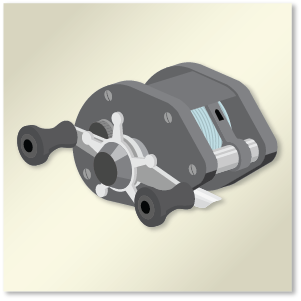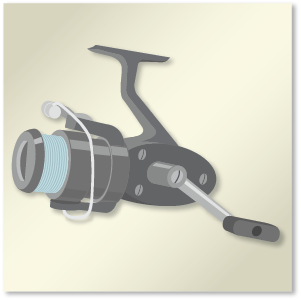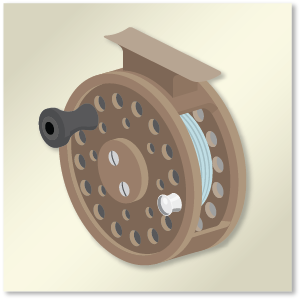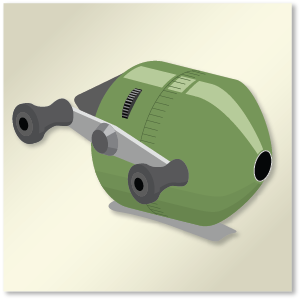Reels
Fishing reels are an important piece of fishing gear that is used along with the fishing rod. The reel holds the line that’s connected to the bait or lure. There’s a reel for every type of fish and fishing style. With the number of reels available for each model, it can be daunting when buying the right one. Reels fall into four categories, baitcasting, spinning, push button and fly. Of the four reels, the spinning reel is the most versatile as it’s available from ultralight to deep sea fishing.
Fishing reels are made from an array of materials including plastic, metal and composites. Metal and composite reels offer the best durability and more features including better gears, bearings and functions. When looking for a reel, comfort should be a priority. A reel with all the desired features won’t get used if it doesn’t feel right when using it. Check that buttons and switches are easy to reach and use, handles and grips are sturdy and don’t slip and gears and bails engage easily when retrieving line.
Below are the four reels mentioned along with their descriptions and uses.
 Baitcasting Reels
Baitcasting Reels
The baitcasting reel, which is used for casting heavier baits and lures, comes in two styles, high and low profile (low profile illustrated). The reel is usually associated with bass fishing where lures such as crankbaits, spinnerbaits, and jigs are used. Another name to describe the baitcasting reel is a level wind. This is because the line is held on the spool in a horizontal position, and an oscillating line guide is used to keep the line even across the spool when casting or reeling. Baitcasting reels are made from either composites, graphite or light aluminum alloys. Composite reels are lighter and usually less expensive, but alloy reels may have an advantage in endurance. It comes down to personal preference and cost.
When looking for a baitcasting reel, a few things need to be considered. The type of fish being sought, type of baits or lures used, and retrieve rate desired. The baitcasting reel works well for bass, catfish, walleye, muskies, and striped bass. This reel can handle line weights from 6 to 30 pounds, and lure weights from 1/4 ounce and upwards. The larger grips on the handle makes it easier for retrieving and fighting fish. The retrieve rate is also important when selecting a baitcasting reel. Retrieve rates range from 3:1 to 7:1. The higher the ratio, the faster the bait can be retrieved. Here again, the type of fishing done will determine the retrieve rate. For catfish or trolling, a lower rate can be used, for bass fishing, a higher rate is usually the best. There are also reels that have transmissions that allow variable retrieve rates with the flip of a switch.
When casting, the line on the baitcasting reel is controlled with the thumb. A thumb bar or push type button is used to disengage the gears into the free spool position. Once the cast is made, a turn of the handle engages the gears. Most baitcasting reels are anti-reverse, meaning the line will not spool off in the engaged position. Some reels have the option of selecting between reverse and anti-reverse. These reels would work well for flipping jigs down through tree branches. In the reverse position, the gears are still engaged, so that when a strike is detected, the hook can be set, and the fish reeled in.
The type of bearings in the reel are also important. The bearings are usually made from composites or stainless steel. Both work well, but the stainless steel bearings have the advantage of endurance. Two types of braking systems or anti backlash controls are also available. The older style is the centrifugal brake. With this system, there are small brake pads that are used to control the speed of the spool when casting. A knob on the side of the reel is used to adjust the tension. The other type, which is more popular today, is magnetic control. In this type of system, the spacing of magnets control the speed of the spool. Again, a knob is used to adjust the spacing. The centrifugal brake system has a slight disadvantage because over time, the brake pads will have to be replaced. Which system to use is a personal preference.
Another feature to consider when choosing a baitcasting reel is an adjustable drag system. The drag system is adjusted using the star wheel next to the handle and allows the line to be pulled off the reel when it’s engaged. This is useful when reeling in a large fish. With a properly adjusted drag, a large fish can be fought and reeled in without breaking the line.
 Spincast Reels
Spincast Reels
The spinning reel, which is used for casting baits and lures of various sizes and weights, comes in just one style, but many sizes. The reel is usually associated with pan fish, trout and bass fishing where lures such as small jigs, minnows, crankbaits, spinnerbaits, and plastic worms are used. Another name to describe the spinning reel is open face. This is because the line is held on an oscillating spool with no cover, and a bail is used to keep the line even across the spool when casting or reeling. The spinning reel, which can be found in sizes ranging from ultralight to heavy are made from either composites, graphite or light aluminum alloys. The composite reels are lighter and usually less expensive, but the alloy reels may have an advantage in endurance. It comes down to personal preference and cost.
When looking for a spinning reel, a few things need to be considered. The type of fish that is sought, type of baits or lures used, and retrieve rate desired. The spinning reel works well for crappie, bluegill, white bass, black bass, and walleye. This type of reel can handle line weights from 2 to 30 pounds, and lure weights from 1/100 ounce and upwards. The large single grip handle makes it easier for retrieving and fighting fish. The retrieve rate is also an important feature when selecting a spinning reel. Retrieve rates range from 3:1 to 6:1. The higher the ratio, the faster the bait can be retrieved. Here again, the type of fishing done will determine the retrieve rate. For still fishing or trolling, a lower rate can be used, for bass fishing, a higher rate is usually the best. Many spinning reels offer the option to place the crank handle on the right or left side.
When casting, the line on the spinning reel is controlled with the index finger. The bail is the only thing that keeps the line on the spool. While holding the line with the index finger, the bail is opened, allowing the line to come off the spool freely when the cast is made, and finger released. Once the cast is made, the turn of the handle flips the bail closed. Most spinning reels have an anti-reverse switch, meaning the line will not spool off in the reverse position. In the reverse position, line can be spooled off while the bail is closed.
The type of bearings in the reel are also important. The bearings are usually made from composites or stainless steel. Both work well, but the stainless steel bearings have the advantage of endurance. The spinning reel does not have a braking system since backlashes do not occur with this type of reel.
Another feature to consider when choosing a spinning reel is an adjustable drag system. The drag system is adjusted using the button at the front of the spool and allows line to pulled off the reel when it’s engaged. This is useful when reeling in a large fish. With a properly adjusted drag, a large fish can be fought and reeded in without breaking the line.
If the spinning reel appeals to you, or you have the need to cast light baits and lures, be sure to check all of the options and features and select a reel that will work for you.
 Fly Reels
Fly Reels
The fly reel, which comes in basically one size, and is used for casting very light baits and lures including tied flies, salmon eggs, jigs, and poppers. The reel is usually made from a combination of composites, plastics, and alloys. The basic feature is the drag control which is used to help tire the fish. Fly reels come in left and right handed models, or some that are interchangeable.
Two styles of fly reels are available, the traditional reel, which is hand cranked, and the automatic reel. The automatic reel has a coiled spring that is wound up before fishing. Though some of these reels have the power to reel in a fish, the automatic coil is usually used for reeling in the line as the fish is brought in.
The function of the fly reel is to hold the line and reel in the fish. The reel has no cast controls since the line is never cast in the conventional manner. The things to consider when looking for a fly reel are the drag control, line capacity, and the overall operation of the reel. This will be determined by the type of fish you’re after. Though fly fishing outfits are usually associated with trout, many anglers use them for catching panfish and bass. So be sure to select or use a reel that will handle what you’re after.
 Push Button Reels
Push Button Reels
The push button reel, which comes in different sizes, and is used for casting baits and lures of various sizes and weights, comes in many styles, but all work the same. Your first reel was probably a push button. The reel is usually made from a combination of composites, plastics, and metals. Some of the features may have changed, but the way the reel works is much the same way. The push button reel is associated with all types of fishing, from panfish to large catfish. Another name to describe the push button reel is closed face. This is because the line is held on an oscillating spool under a cover, and a line pickup is used to keep the line even across the spool when casting or reeling.
When looking for a push button reel, a few things need to be considered. The type of fish that is sought, type of baits or lures used, and retrieve rate desired. As mentioned before, the push button reel can be used for fish ranging from panfish to catfish. The smaller the reel, the lighter the line and baits that can be used. The large grips found on most of today’s push button reels make it easier for retrieving and fighting fish. Retrieve rates range from 3:1 to 4:1. The higher the ratio, the faster the bait can be retrieved. Here again, the type of fishing done will determine the retrieve rate. For still fishing or trolling, a lower rate can be used, for bass fishing, a higher rate is usually the best.
When casting, the line on the reel is controlled with the thumb on the push button. While holding down the button with the thumb, the line pickup is retracted. When the cast is made, the button is let up allowing the line to come off the spool. The line can be controlled or stopped by pressing the button. Once the cast is made, a turn of the handle opens the pickup and resets the button. Most push button reels have an anti-reverse switch, meaning the line will not spool off in the anti-reverse position. In the reverse position, the line can be spooled off while the pickup is open.
The type of bearings in the reel are also important. The bearings are usually made from composites or stainless steel. Both work well, but the stainless steel bearings have the advantage of endurance. The push button reel does not have a braking system since backlashes do not occur with this type of reel.
The drag system on a push button reel is adjusted using a dial found on top of the reel and allows line to pulled off the reel when it’s engaged. This is useful when reeling in a large fish. With a properly adjusted drag, a large fish can be fought and reeded in without breaking the line.
If it’s all-around fishing that’s going to be done, or if you or a child are just starting out, a push button reel might be the right choice.
